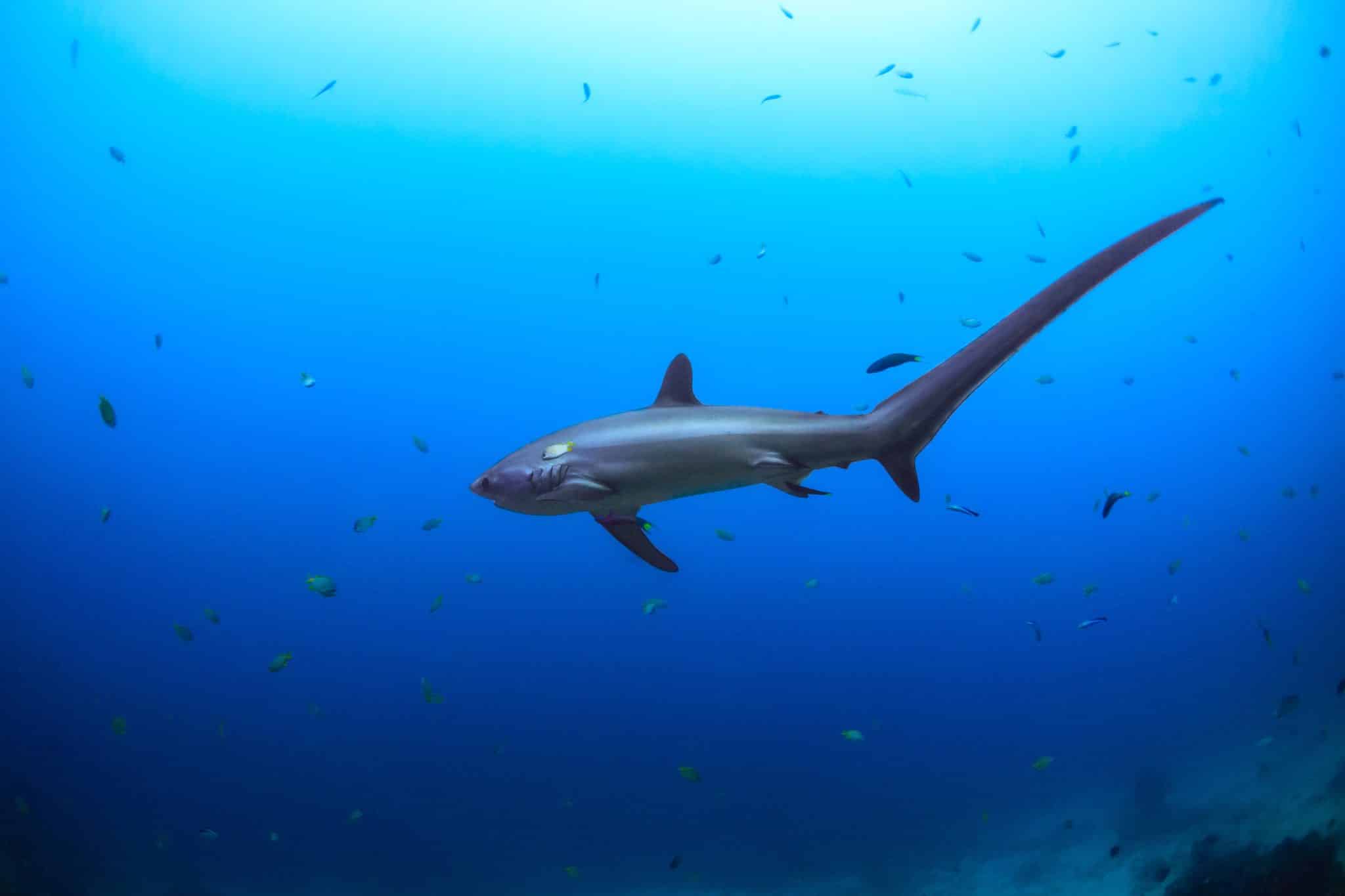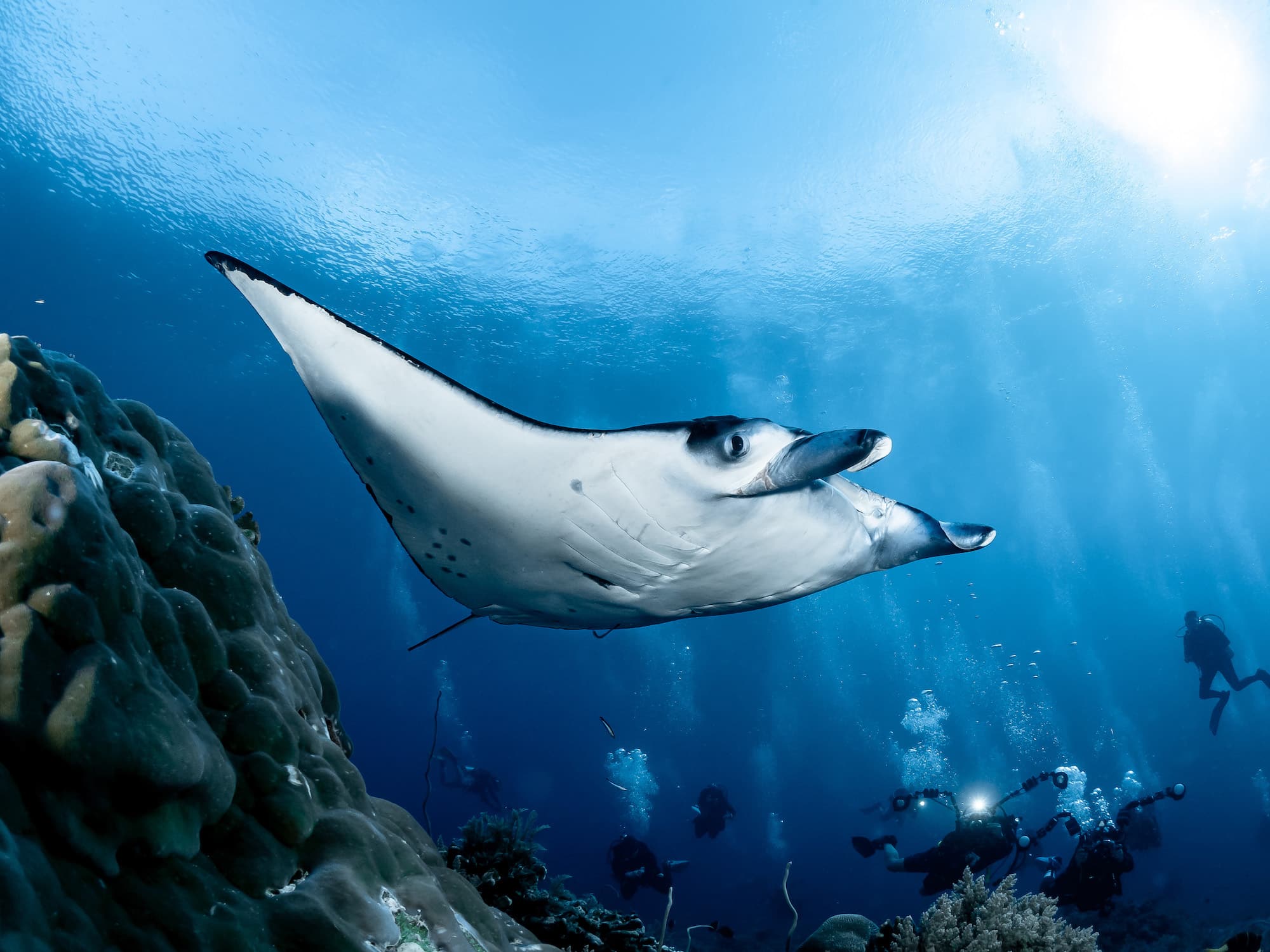News
Five best places to find Big Fish in the Philippines

Guest Blog by Phil North
Divemaster Phil North, from Dive Worldwide shares his five best spots to find Big Fish in the Philippines.
If diving with the ocean’s giants is on your bucket list, the Philippines is the perfect destination. Whale sharks, striped barracudas, turtles, hammerheads, manta rays, dugongs, and even 2-metre-long Napoleon wrasse can be found here.
The Philippines is in the Coral Triangle – the most biodiverse coral reef on the planet – so its waters are bursting with marine life, including large pelagics, sponges, and over 2,500 species of fish.
So where should you visit to see the biggest and most exciting species? There are over 7,000 islands in the archipelago and several world-class diving sites to choose from, so read Dive Worldwide’s guide to discover the best diving spots for big fish encounters in the Philippines.
Outstanding marine biodiversity and reef sharks
If you’re after an abundance of big fish, the UNESCO World Heritage Site of Tubbataha will not disappoint.
The dive season runs from March to June, with a chance to see a spectacular range of species, including tiger shark, hammerhead, leopard shark, grey reef shark, nurse shark, manta, marble and eagle ray, whale shark, barracuda, tuna, hawksbill and green turtle, and dolphins.
Tubbataha is the largest marine protected area in the Philippines and offers superb diving opportunities. It is located 150 kilometres from Palawan in the Sulu Sea, so you will need a liveaboard to access these world-class dive sites.
Recommended dive trip:
Tubbataha Liveaboard
When to go: April – June
Shark Encounters – rare thresher sharks
Shark enthusiasts will love this world-famous diving location.
Monad Shoal, also known as Shark Point, is the only place in the world where rare thresher sharks can be seen daily.
This iconic, but usually shy, species gets its name from the distinctive tail which it uses like a whip when hunting. Here, you can encounter thresher sharks as they are swimming around the cleaning stations in the shallow reefs. You may also find white-tip, black-tip, bamboo, and nurse sharks in these waters.
With beautiful coral gardens and white sands to rival Boracay, Malapascua is a popular destination for divers and holiday-makers alike.
Recommended dive trips:
Big Fish Tour
When to go: November – April (but possible all year)
Visayas Liveaboard
When to go: April – June
Sharks & Reefs
When to go: All year round
World’s largest rays and fish
Bicol – Donsol and Ticao Island
These popular diving destinations are frequent haunts of the world’s biggest ray and fish species – the oceanic manta ray and the whale shark.
The Manta Bowl dive site, in Ticao Pass, is famous for its manta ray population and for being one of the best diving sites in the Philippines.
Whale sharks migrate to Donsol between late November and May, which is the best time to enjoy close encounters. Although whale sharks can exceed 15 metres long, they are gentle giants that filter-feed on plankton, krill, and small plants.
Recommended trips:
Big Fish Tour
When to go: November – April (but possible all year)
Reef sharks, hammerheads and schools of pelagic fish
Apo Reef is one of the most celebrated dive sites in the Philippines and an excellent place to find sharks or other big pelagics. Hammerheads are one of the top attractions in these waters, but black and whitetip sharks, and even occasionally thresher sharks visit here. You can also expect to encounter other large species like groupers, tuna, eagle and manta rays, large trevally, turtles and, if you are lucky, dolphins.
Recommended trips:
Club Paradise Resort – offering daily dive trips to Apo Reef
When to go: anytime
Liveaboards
When to go: April – December
Barracuda, turtles and dugong
North of Palawan – Coron
We know, not all these species are technically fish, but they are impressively large pelagics.
Dugong, also known as sea cows, were even thought to have inspired sailor’s stories about mermaids! This near-mythical marine mammal is listed as a vulnerable species on the IUCN Red List, but you may be lucky enough to spot one on an eco-tourism dive in Coron.
At Barracuda Lake, you can look out for the legendary giant barracuda (though even the regular ones can be over a metre long). This is also a great location for viewing green and hawksbill turtles.
Recommended trips:
Dive Coron Bay on Sangat Island (also excellent for wreck diving)
When to go: October – June
Liveaboards
When to go: April – December
Top choice for big fish encounters:
Big Fish Tour
This underwater safari visits some of the best sites for whale shark, thresher shark, and manta ray encounters. The two-week tour includes up to 14 diverse and exciting dives, with stays at relaxing tropical beachfront resorts.
Find out more
 Get in touch with the friendly Dive Worldwide team for first-hand advice on your next diving holiday to the Philippines. They offer a superb range of resort and liveaboard options. Visit the website, send an enquiry, or call the expert team on 01962 302087.
Get in touch with the friendly Dive Worldwide team for first-hand advice on your next diving holiday to the Philippines. They offer a superb range of resort and liveaboard options. Visit the website, send an enquiry, or call the expert team on 01962 302087.
Gear News
Introducing the TR-80, IR-50 and CS-30 Regulators from DYNAMICNORD

Whether you are a beginner or a professional diver – with the three new main regulators from DYNAMICNORD, everyone will find their favourite regulator. They all look super stylish.
Excellent performance with the TR-80
Quality and performance are the be-all and end-all for regulators. It is not for nothing that the TR stands for Tec Reg. The innovative design of the TR-80 guarantees absolute reliability – even in ice-cold waters.

Perfect breathing effort at 0.8 J/l / certified for diving in waters below 10 degrees / structural design made of solid brass for best cold protection / membrane-compensated design with dry seal of the first stage / reduced exhalation effort thanks to optimized exhalation membrane and bubble deflector / adjustable Venturi (dive/predive) and adjustment knob for individual inhalation comfort / innovative design of the front cover prevents free-flow in strong currents or when diving with scooters / design made of sandblasted brass, matt chrome finish / 2 HP and 4 LP outlets / mouthpiece made of high-quality, anti-allergic silicone for maximum comfort.


Amazing underwater adventures with the IR-50
The IR-50 is the top regulator for advanced and experienced divers. Natural breathing is the essence of this regulator.

Ideal breathing effort at 0.8 J/l /certified for diving in waters below 10 degrees / compensated membrane / adjustable venturi (dive/predive) and adjustment knob for individual inhalation comfort/ outlet valve and deflector for minimum exhalation effort and reduction of bubbles on the face / design made of sandblasted brass, matt chrome finish / 2 HP and 4 NP outlets / mouthpiece made of high-quality, anti-allergic silicone for maximum comfort.


The Workhorse – our CS-30
For diving centres and diving beginners – the workhorse stands for strong construction, reliability and robustness. Perfect for your training.

Optimal breathing effort at 0.8 J/l /recommended for diving in waters above 10 degrees / non-compensated piston / adjustable venturi (dive/predive) / outlet valve and deflector for minimum exhalation effort and reduction of bubbles on the face / design made of sandblasted brass, matt chrome finish / 1 HP and 3 NP outlets / mouthpiece made of high-quality, anti-allergic silicone for maximum comfort.


Octopus OP-30
The OP-30 is the ideal addition to all DYNAMICNORD regulators. It is identical in construction to the CS-30.

The TR-80, IR-50, CS-30 (DIN & INT) regulators and the Octopus OP-30 are available from DYNAMICNORD dealers and in the online store.
DYNAMICNORD – Your Outdoor Companion.
Marine Life & Conservation
Paul Watson Released as Denmark Blocks Japan’s Extradition Bid

Renowned anti-whaling activist Paul Watson has been released from custody in Greenland after spending five months in detention. Denmark’s Justice Ministry rejected Japan’s request for his extradition, citing insufficient guarantees that his time already served in custody would be credited against any potential sentence.
The 74-year-old Canadian-American was arrested on July 21 in Nuuk, Greenland’s capital, when his ship docked to refuel. His arrest was based on a 2012 Japanese warrant related to a 2010 encounter in Antarctic waters. Japan alleged Watson obstructed operations and caused damage to a whaling research ship during efforts to disrupt illegal whaling. Watson has consistently denied these claims, maintaining his commitment to marine conservation.
Denmark, which oversees extradition matters for Greenland, concluded that while the legal conditions for extradition were met, the lack of assurances from Japan regarding time-served credit made extradition untenable.
In a video shared by his foundation, Watson expressed gratitude and relief, saying, “After five months, it’s good to be out… and good to know they’re not sending me to Japan.” He added that the most difficult part of his time in custody was being separated from his two young sons.
Watson is a pioneering figure in marine conservation, known for founding the Captain Paul Watson Foundation in 2022 after decades of activism with the Sea Shepherd Conservation Society. His bold efforts to defend marine life have earned him widespread support, including from celebrities and conservationists. His work has also been featured in the acclaimed reality TV series Whale Wars.
Watson’s lawyer, Jonas Christoffersen, praised the decision, stating, “We are happy and relieved that Paul Watson is now free.” He added that Watson is eager to reunite with his family and continue his vital work.
The arrest occurred while Watson’s vessel, the M/Y John Paul DeJoria, was en route to the North Pacific with a team of 26 volunteers to intercept a Japanese whaling ship. His foundation described the arrest as politically motivated and emphasized that Watson’s actions were focused on ending illegal whaling practices.
Japan resumed commercial whaling in 2019 after leaving the International Whaling Commission, asserting that whale meat is a cultural tradition. Conservationists, however, continue to challenge these practices, highlighting their impact on marine ecosystems.
Despite the challenges, Watson remains steadfast in his mission to protect marine life and bring attention to whaling practices. His dedication to ocean conservation has made him a globally respected advocate for the environment.
-

 News2 months ago
News2 months agoIconic SS United States to become the World’s Largest Artificial Reef
-

 News3 months ago
News3 months agoBook Review – 52 Assignments: Underwater Photography
-

 Gear News3 months ago
Gear News3 months agoDYNAMICNORD – New German diving brand enters the British market
-

 News3 months ago
News3 months agoExploring Cenote El Pit: A Diver’s Dream
-

 Gear News3 months ago
Gear News3 months agoTry BARE drysuits (and maybe even win one!) this Friday with Sea & Sea at North West Dive Fest
-

 Marine Life & Conservation3 months ago
Marine Life & Conservation3 months agoBook Review: Coral Triangle Cameos
-

 Blogs2 months ago
Blogs2 months agoDive the Egyptian Red Sea this Autumn with Regaldive
-

 News3 months ago
News3 months ago2024 Ocean Art Underwater Photo Competition Announced




















